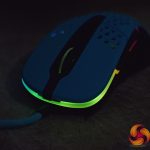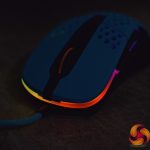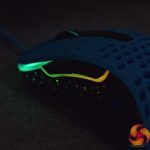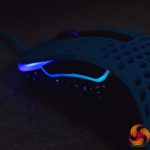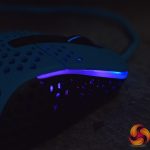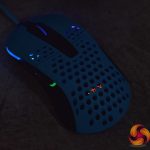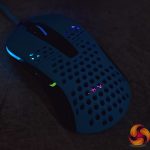To test the M4, I used it as my daily driver for almost two weeks. We break down testing into four main sections: on-board controls, lighting, build quality and comfort, and performance.
On-board controls
Usually we look at a mouse's software first, but as the M4 has no software, Xtrfy has built a number of controls into the mouse itself which are accessible by pressing various combinations of buttons.
All of the controls are detailed in the M4's quick-start guide – PDF HERE – but to give you some examples of what controls are available:
- Pressing the RGB button + right click changes the colour of the LEDs.
- Pressing the RGB button + side buttons increases or decreases LED brightness.
- Pressing the RGB button + left click adjusts the speed of the RGB effect.
And that is it. I do like having the option to tinker with the RGB control without the need for software, and I can also understand Xtrfy's decision to not include software – it's cheaper from a development perspective as no time has to be spent developing the software, and it also means there's nothing to download or potentially bug-out in use.
Then again, there's a lot of functionality missing without any software. There's no control over the DPI stages – you have to use all 8 and they can't be adjusted – while there is also no control over lift-off distance, you can't create different profiles and so on. For me, having a lightweight software suite only helps, and at the very least, if a mouse has on-board memory, users can download it, adjust their settings, save them to the on-board memory, and then uninstall the software. With the M4, however, we don't get that option.
Lighting
As for the lighting itself, there's a fairly long LED strip at the front of the mouse which extends about halfway down the sides of the M4. The Xtrfy logo positioned on the PCB is also an RGB zone, so you can see it through the holes in the top shell. While the overall control of the RGB effects is limited to whatever you can adjust via the on-mouse controls – effects include static colour, breathing, colour wave, colour cycle – I do think it's quite a tasteful implementation. The LEDs are nice and bright while the colours look good. I am also a big fan of the RGB lighting peeping through the holes in the mouse's shell. For a mouse like the M4, the RGB is certainly not a cause for complaint.
Build quality and comfort
Overall build quality of a sub-70g mouse is always going to be an interesting area, particularly when the entire shell is filled with holes. That being said, I have been very impressed by how robust and well-built the M4 is.
For starters, I couldn't detect any creaking or flexing when applying pressure to the top of the shell – there was no give in the plastic even when pushing down unreasonably hard with both thumbs, which is certainly more than can be said for some other ultra-lightweight mice I have tried recently.
Additionally, there was no audible rattle from the M4 when I picked it up and gave it a good shake. The primary buttons exhibit very little lateral movement, too – there is some movement, but this is only noticeable when deliberately pushing the buttons side to side, in normal use this was not an issue at all.
As with all other ultra-lightweight mice I have tested, you can actuate the side buttons by squeezing the sides of the M4. However, the amount of force required to do so is unreasonably high so I can say with confidence that accidental actuation would not happen during normal use, it's only when deliberately squeezing the mouse with considerable force that it becomes noticeable.
Moving onto comfort and grip styles, I personally got on really well with the M4. To be clear, the distinctive shape means this won't be for everyone, but if you like other ergonomic mice like the Zowie EC series, Logitech G403 or SteelSeries Rival, the M4 could be right up your street.
I typically use a claw grip and while that is no problem with the M4, I found myself using it with more of a claw/palm hybrid grip – the outward curve on the left-hand side of the mouse definitely lends itself to sitting in your palm. True palm grip is also possible and is comfortable, but due to the size of the M4 this is only going to be an option for those with smaller hands. Mine measure 18.5x9cm and I was just on the limit for using this mouse comfortably with a palm grip.
Fingertip should also be OK for most users, it's possible the curve on the left-hand side may get in the way for some people, but overall the M4's shape caused me no problems and it's certainly worth trying if you typically prefer ergonomic designs.
Performance
Starting our performance testing section with the primary buttons, these are very good indeed. The click is light and crisp, with just a bit of post-travel – I'd say slightly more than the G403, which has the best primary buttons I've ever used, but this is right up there in terms of overall tactility and speed at which you can spam the buttons.
The Huano yellow switches are also excellent for the side buttons. I'd not used Huano yellows before and it's a very light switch, which is my personal preference, so I was again able to repeatedly mash these side buttons at high speed. The only negative aspect of the side buttons is a small amount of pre-travel, but it didn't cause me any issues in-game.
As for the scroll wheel, this is another strong area for the M4. Scrolling is tight and with well-defined steps, there's no lateral movement from the wheel and it requires a medium amount of force to click down. There's really nothing to complain about there.
Moving onto sensor performance then, as expected when seeing that the PMW 3389 that has been deployed with the M4, I had no issues in terms of tracking. Of the 8 DPI stages, I was most comfortable at stage 3 – 1200 DPI – and there I found movements to be as precise and controlled as with any other PWM 3389-based mouse. There's also no noticeable acceleration or jitter either, so apart from the fact the user can't set their own DPI setting, this is as good as it gets.
Lift-off distance (LOD) is another area to touch on, and things are very simple here – there's no way to adjust LOD, and the mouse stops tracking from just 1 DVD high. I've always kept LOD as low as possible so personally I think this is great. However, should you want to install third-party mouse feet, or if you like a higher LOD, then that is just not possible due to the lack of software.
Finally we come to the cable. Xtrfy calls this the ‘EZCord' and overall it is certainly a decent cable – I'd probably put it on the same level as the Model O in terms of flexibility. There is just a bit of initial stiffness which I tried to work out by flexing the cable backwards and forwards, and that did seem to help a bit. However, for me the Cooler Master MM711 is the clear leader with its ‘ultraweave' cable, so while I'd definitely class the EZCord as ‘good', it is still not ‘the best'.
 KitGuru KitGuru.net – Tech News | Hardware News | Hardware Reviews | IOS | Mobile | Gaming | Graphics Cards
KitGuru KitGuru.net – Tech News | Hardware News | Hardware Reviews | IOS | Mobile | Gaming | Graphics Cards


